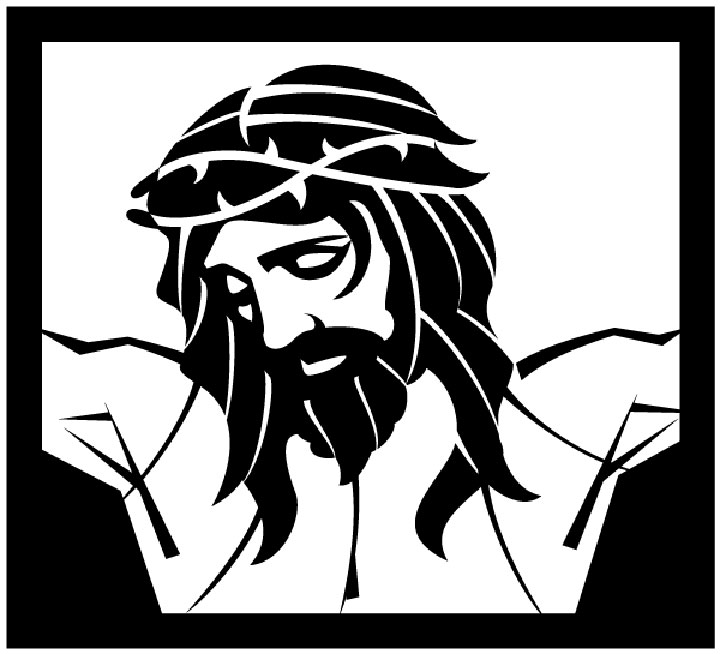 What does Jesus Christ—or John Steinbeck or Robert Frost—really mean to me? John Steinbeck: A Biography by the writer Jay Parini helped me understand why Steinbeck’s life and work spoke to me so powerfully when I first began reading Steinbeck’s books. Robert Frost is another favorite, and Parini—a professor of creative writing at Middlebury College—brought his fellow New England poet’s interior landscape into focus for me with Robert Frost: A Life, his second work of biography. A celebrated Middlebury College faculty member for more than 30 years, Parini has employed his enviable skills as a poet, novelist, and scholar to re-imagine the life of Jesus Christ—the greatest story of them all—in Jesus: The Human Face of God.
What does Jesus Christ—or John Steinbeck or Robert Frost—really mean to me? John Steinbeck: A Biography by the writer Jay Parini helped me understand why Steinbeck’s life and work spoke to me so powerfully when I first began reading Steinbeck’s books. Robert Frost is another favorite, and Parini—a professor of creative writing at Middlebury College—brought his fellow New England poet’s interior landscape into focus for me with Robert Frost: A Life, his second work of biography. A celebrated Middlebury College faculty member for more than 30 years, Parini has employed his enviable skills as a poet, novelist, and scholar to re-imagine the life of Jesus Christ—the greatest story of them all—in Jesus: The Human Face of God.
The new book represents a progression, not a departure, for Parini. John Steinbeck was a lifelong Episcopalian who considered Jesus Christ a moral genius, read and raided the Bible for his fiction, and once thought about writing the screenplay for a Jesus Christ biopic based on the gospels that was never made. Like Robert Frost, Steinbeck valued personal privacy and resisted dogmatic assertions of belief, so we’ll never know how his Christ would have fared on film. For that matter, what do we really know about the details of Jesus’ life from historic records? American writers before and since Steinbeck—including the late Duke University novelist and poet Reynolds Price—have rescripted the Man from Galilee with intriguing angles and uneven results. Now an inspired and imaginative writer from Middlebury College—one of America’s oldest and finest schools—has succeeded where others failed.
Jay Parini: The Man from Middlebury College
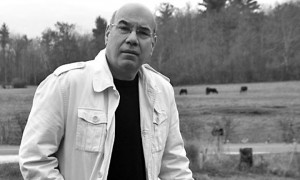 Like young John Steinbeck growing up in what became Steinbeck Country, Jay Parini is active in his Episcopal church, located not far from Middlebury College in Robert Frost Country, the home turf of Steinbeck’s New England grandparents. Unlike Steinbeck, Parini is fluent in New Testament Greek; like the author, he knows his Bible and his theology and has explored other traditions—Taoism, Buddhism, Hinduism—in depth. But I suspect that none of that is unusual around Middlebury College, long a center of language and cultural studies without equal for its size. Resurrecting Jesus Christ from the tomb of time as Parini has done requires a tool more powerful than scholarship, even the industrial-strength form found in the halls of Middlebury College. Re-mythologizing (Parini’s term) requires an eye for the unseen, an ear for the unknowable, and a writer’s way with words. After three decades of practice writing for mainstream readers, Parini possesses these gifts in abundance. His first collection of poems appeared in 1982. His most recent novel was published in 2010. Four years ago his third novel—The Last Station—became an Academy Award-nominated movie.
Like young John Steinbeck growing up in what became Steinbeck Country, Jay Parini is active in his Episcopal church, located not far from Middlebury College in Robert Frost Country, the home turf of Steinbeck’s New England grandparents. Unlike Steinbeck, Parini is fluent in New Testament Greek; like the author, he knows his Bible and his theology and has explored other traditions—Taoism, Buddhism, Hinduism—in depth. But I suspect that none of that is unusual around Middlebury College, long a center of language and cultural studies without equal for its size. Resurrecting Jesus Christ from the tomb of time as Parini has done requires a tool more powerful than scholarship, even the industrial-strength form found in the halls of Middlebury College. Re-mythologizing (Parini’s term) requires an eye for the unseen, an ear for the unknowable, and a writer’s way with words. After three decades of practice writing for mainstream readers, Parini possesses these gifts in abundance. His first collection of poems appeared in 1982. His most recent novel was published in 2010. Four years ago his third novel—The Last Station—became an Academy Award-nominated movie.
Resurrecting Jesus Christ from the tomb of time as Parini has done requires a tool more powerful than scholarship . . . .
Parini’s first venture beyond poetry was his life of John Steinbeck, released in 1994 by Steinbeck’s English publisher (cover image below) and published in the USA in 1995. It was followed by two more literary lives, those of Robert Frost (2000) and William Faulkner (2004), making Jesus Christ Parini’s fourth act biography, a challenging art-form that doesn’t always produce miracles. Among the academically inclined, Parini’s The Art of Teaching (2005) and Why Poetry Matters (2008), plus a host of anthologies, have attracted acclaim. Promised Land: Thirteen Books That Changed America (2008) remains a vade mecum for those exploring the topography of American fiction for the first time. Film adaptations of a pair of Parini novels—Benjamin’s Crossing (1997) and The Passages of H.M. (2010)—are underway. Galliano’s Ghost, another novel, is in progress. So is Conversations with Jay Parini, a University of Mississippi Press publication edited by Michael Lackey. In case you’re counting, that puts him just about where John Steinbeck was at a comparable point in his dizzingly diverse career as a writer.
John Steinbeck: A Life
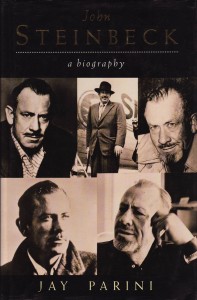 Like Steinbeck, Parini has his critics. I learned this when I answered a Steinbeck scholar’s recent query. What’s your favorite Steinbeck biography? I replied that I still loved the first one I ever read—John Steinbeck: A Biography. If looks could kill, Parini’s book and I both died that day. Had I spoken heresy? If so, I guess I understand. I too have found reason to quibble with minor points in Parini’s life, published years after another biographer’s much longer book, in my recent research into Steinbeck’s religious roots. But—pardon me—Jesus Christ! Do you want good footnotes or great style? Better than any other biographer I know of John Steinbeck or Robert Frost, Parini sees his subject steadily and sees him whole, telling a creative writer’s story as only a creative writer can. If you’re curious about the time the particular author you’re studying went to the bathroom in his publisher’s office on a given day, be my guest—find the longest biography you can. If you want to know how he recalibrated a certain character, re-imagined a significant scene, or overcame writer’s block to meet a deadline, ask another writer. For John Steinbeck and Robert Frost, Jay Parini more than meets this taste test.
Like Steinbeck, Parini has his critics. I learned this when I answered a Steinbeck scholar’s recent query. What’s your favorite Steinbeck biography? I replied that I still loved the first one I ever read—John Steinbeck: A Biography. If looks could kill, Parini’s book and I both died that day. Had I spoken heresy? If so, I guess I understand. I too have found reason to quibble with minor points in Parini’s life, published years after another biographer’s much longer book, in my recent research into Steinbeck’s religious roots. But—pardon me—Jesus Christ! Do you want good footnotes or great style? Better than any other biographer I know of John Steinbeck or Robert Frost, Parini sees his subject steadily and sees him whole, telling a creative writer’s story as only a creative writer can. If you’re curious about the time the particular author you’re studying went to the bathroom in his publisher’s office on a given day, be my guest—find the longest biography you can. If you want to know how he recalibrated a certain character, re-imagined a significant scene, or overcame writer’s block to meet a deadline, ask another writer. For John Steinbeck and Robert Frost, Jay Parini more than meets this taste test.
Do you want good footnotes or great style?. . . For John Steinbeck and Robert Frost, Jay Parini more than meets this taste test.
Like Steinbeck’s fiction, Parini’s biography of John Steinbeck continues to be popular with readers who are not writing dissertations. I recommend it to anyone interested in learning how Steinbeck developed his craft and overcame his problems. I reread it so often it because it flows so well—unimpeded by anxious over-annotation, syntactical complexity, or current critical cant. Parini’s life of Robert Frost—a natural next subject for a Middlebury College poet-biographer—has the same value for non-natives entering Robert Frost Country for the first time. I’m a Southerner, but I’ll confess that I haven’t read Parini’s biography of William Faulkner, John Steinbeck’s fellow-Nobel Laureate and sometime competitor. My excuse? In graduate school ions ago I studied Faulkner under a meticulous biographer who read from his notes for the prodigious life of Faulkner he was writing. Information without imagination. Not Jay Parini’s problem.
Thinking about Jesus Christ with John Steinbeck in Mind
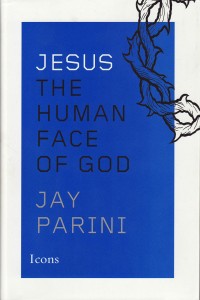 We can’t know with confidence how Steinbeck’s film Christ would have acted or even looked. But the Jesus brought to fresh life in Parini’s new biography seems just like one of us, only more so. I kept thinking of Steinbeck as I read the book. Though Steinbeck claimed to have no religion (not that odd for an Episcopalian), he disliked reading scripture in any version other than King James, which he knew like, well, the bible. In his new narrative Parini sticks to King James for big stuff like the Beatitudes. But for most of the passages he quotes from or about Christ he provides his own translation—immediate, clear, compelling—in fulfillment of his promise to lift Jesus from the pile of dogma, myth, and demythologizing that have smothered the Christ story. Along the way he quotes other poets, cites other scholars, and acknowledges other teachers at Middlebury College, all without losing momentum or focus for a second. His Jesus Christ is a living teacher speaking in an existential now with something to say to all people. As a believer Parini is passionate about his subject. As a teacher he is careful about his approach. The result? Jesus: The Human Face of God is like a well-taught introductory course in a class of non-majors. No declared religion is required to participate, and doubt is more than welcome. In fact it’s advised.
We can’t know with confidence how Steinbeck’s film Christ would have acted or even looked. But the Jesus brought to fresh life in Parini’s new biography seems just like one of us, only more so. I kept thinking of Steinbeck as I read the book. Though Steinbeck claimed to have no religion (not that odd for an Episcopalian), he disliked reading scripture in any version other than King James, which he knew like, well, the bible. In his new narrative Parini sticks to King James for big stuff like the Beatitudes. But for most of the passages he quotes from or about Christ he provides his own translation—immediate, clear, compelling—in fulfillment of his promise to lift Jesus from the pile of dogma, myth, and demythologizing that have smothered the Christ story. Along the way he quotes other poets, cites other scholars, and acknowledges other teachers at Middlebury College, all without losing momentum or focus for a second. His Jesus Christ is a living teacher speaking in an existential now with something to say to all people. As a believer Parini is passionate about his subject. As a teacher he is careful about his approach. The result? Jesus: The Human Face of God is like a well-taught introductory course in a class of non-majors. No declared religion is required to participate, and doubt is more than welcome. In fact it’s advised.
His Jesus Christ is a living teacher speaking in an existential now with something to say to all people.
The unsmiling Jesus Christ depicted in classic Orthodox iconography (as in the cover image below) seems distant, two-dimensional, hard to embrace, at least for me. Parini’s Jesus, like John Steinbeck’s Ma Joad, is bigger than life but also fully formed, and in the end all-forgiving. The confusing nomenclature of the Bible presents another obstacle to understanding for many. Since I was a kid memorizing the books of the Bible for Sunday school to the time I took the required Old and New Testament courses (both excellent) in college, I’ve felt foggy about biblical names of greater complexity than Paul or Peter and theological ideas more complicated than I Am That I Am. Parini cleared some air in my head.
Parini’s Jesus, like John Steinbeck’s Ma Joad, is also bigger than life but fully formed, and in the end all-forgiving.
For example, I could never keep my Sadducees and my Pharisees straight. No longer! Parini traces the origin of the Sadducees to Saduc, “a legendary high priest from the time of King David,” and describes the group as an easygoing, cultured elite who looked down on their neighbors the Pharisees, seriously doubted the doctrine of bodily resurrection, and deeply enjoyed hobnobbing with foreigners: Episcopalians! The Pharisees? Puritanical, parochial, sure of their salvation—Presbyterians! That confusing half-human, half-divine thing about the true nature of Jesus Christ? Aha! It started with the Romans, maybe earlier. Virgin Birth? Greek and Persian, not Hebrew. Satan? Definitely Hebrew—ha-Satan. Marriage? Jesus Christ was single, but he loved women, knew how to kiss, and produced wine at a wedding over the objections of his mother, a miracle that would have moved a drinker like Steinbeck deeply.
Jesus Christ was single, but he loved women, knew how to kiss, and produced wine at a wedding over the objections of his mother, a miracle that would have moved a drinker like Steinbeck deeply.
In fact, Parini’s Jesus Christ embodies John Steinbeck’s most enviable qualities as a writer and his most admirable aspirations as a man. Listen:
You talked to women without troubling over gender rules. You confronted people about their past lives, their current situation. You didn’t worry about their racial or political origins but sought to bring them into a state of reconciliation with God, a condition of atonement that would fill them with “living water” that reached beyond physical thirst.
Parini’s Jesus Christ loves water, enjoys boats, and is at ultimate ease around fisherman, three constants in John Steinbeck’s sea-sotted life. Jesus is even friendly to tax-collectors (Steinbeck’s father was the county treasurer) and—like Steinbeck—he hated poverty, despised cruelty, and always stuck up for the underdog without starting a war. As Steinbeck, so Jesus: sin is Karma, and it starts inside: “Forgiveness leads to godly behavior”— “anger leads to murderous behavior.” Like Cain and Abel in East of Eden, Parini’s Jesus “takes his listeners back to the origins of murder, anger itself.” Like John Steinbeck in his time, Parini’s Jesus considers affluence a cause of poverty, advising “insane generosity, especially if you love it.” More: “annoy, even outrage, the elite classes. . . .” That’s the mantra Middlebury College had back in my day. I hope it is now. It was certainly Steinbeck’s, starting at Stanford.
Both Jesus and John Made Their Own Myth
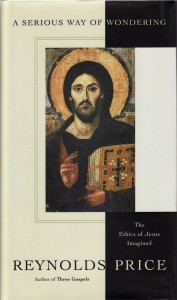 Like John Steinbeck, Parini’s Jesus Christ is the maker of his own myth—a slippery term of art in literature that Parini nails down as story. It’s the same meaning Steinbeck had in mind when he resisted the idea of his life story being written while he was still alive, preferring instead to create his own life myth—and not just in novels. So, in his way, with Parini’s Jesus Christ: “One gets the sense that Jesus, knowing the plot of his own story, had arranged everything in advance.” Steinbeck was also skeptical of sudden revolution and instant redemption—much like Parini’s Jesus. Steinbeck on history: Man’s war is with himself. Progress is certain but slow. Peace starts with you. Parini on Christ:
Like John Steinbeck, Parini’s Jesus Christ is the maker of his own myth—a slippery term of art in literature that Parini nails down as story. It’s the same meaning Steinbeck had in mind when he resisted the idea of his life story being written while he was still alive, preferring instead to create his own life myth—and not just in novels. So, in his way, with Parini’s Jesus Christ: “One gets the sense that Jesus, knowing the plot of his own story, had arranged everything in advance.” Steinbeck was also skeptical of sudden revolution and instant redemption—much like Parini’s Jesus. Steinbeck on history: Man’s war is with himself. Progress is certain but slow. Peace starts with you. Parini on Christ:
Recognition takes time, becoming in fact a process of uncovering, what I often refer to in this book as the gradually realizing kingdom: an awareness that grows deeper and more complex, more thrilling, as it evolves.
Parini’s life of Jesus Christ, like the fiction of John Steinbeck, engaged me as a participant, not on the sidelines. Occasionally I got so involved I even wanted to add things, as Steinbeck urges us to do when we participate in his stories and continue them in our lives, where they have their true ending. One example must suffice. Late in the his Jesus story Parini pauses to reflect on the unrecognized irony—“lost on our ears now”—implicit in the name of the rebel Bar-abbas, “son of the father,” freed by Pilate in place of Jesus. How I hoped Parini w0uld stop to savor another, deeper irony, spoken by Christ himself to the Sanhedrin shortly before he’s delivered to the Romans: “Render unto Caesar what is Caesar’s.” Hear what Jesus is saying? Your assumptions are all wrong. Nothing is Caesar’s. Everything belongs to God.
This life reminds this reader why Jesus Christ, like John Steinbeck and Robert Frost, has found an ideal biographer in the churchgoing poet-novelist from progressive Middlebury College. Like Jay Parini, John Steinbeck was a socially-conscious Episcopalian storyteller writing for the multitude. Like Robert Frost, Middlebury College sprang from the soil and salt of Steinbeck’s paternal New England, where Parini makes his home. And Jesus Christ loved us all. This book tells me that Jay does too.


Excellent article, Will. It occurs to me that aside from perhaps the NY Review of Books, a site like yours is ideal for this kind of wide-ranging, generous, and synthetic criticism. Regarding Parini’s Jesus, I recognize that he is writing for a general audience (and succeeding wildly on that account, as always), but I wonder how his Jesus book squares with the recent rise in scholarship on “historical Jesus.”
Nick, you make the right connection with your question, but Jay rides in the opposite direction in his biography. After summarizing the modern search for the so-called historic Jesus in his preface, he notes that he’s interested in ‘re-mythologizing’ Christ in response to the rationalizing habit of 19th and 20th century biblical thinkers, such as those who comprise the recent Jesus Seminar. A similar strain of Jesus-demystification, exemplified by Thomas Jefferson in his oft-cited edition of Jesus’ ethical teachings, recurs in creative writers like Reynolds Price, who is referred to in my review of Jay’s book. Jay’s Jesus is much more like your Junipero Serra, Nick–a fully developed character with a powerful secret. What a pleasure to have the chance to read and review two books of novelistic power like yours and Jay’s in the space of five weeks! Thank you for your query.
Does this mean Steinbeck was a Christian, or was he an atheist who used Christian allegories to get his points across? Always been a fan of his, and am amazed at how well he knew and understood Jesus–and yet so many claim he was an atheist.
John Steinbeck was christened, reared, and memorialized in the Episcopal Church and was intimately familiar with the Bible. Here is a brief blog post about his religious roots in Salinas:
https://www.steinbecknow.com/2013/09/26/john-steinbecks-life-episcopal-church/